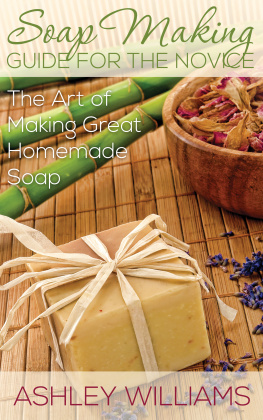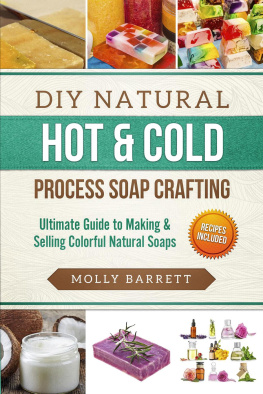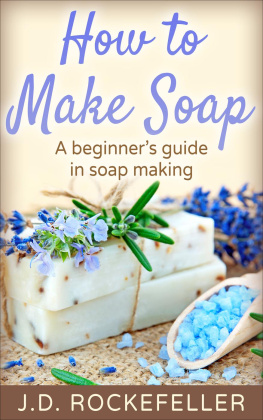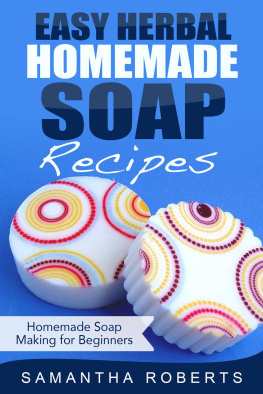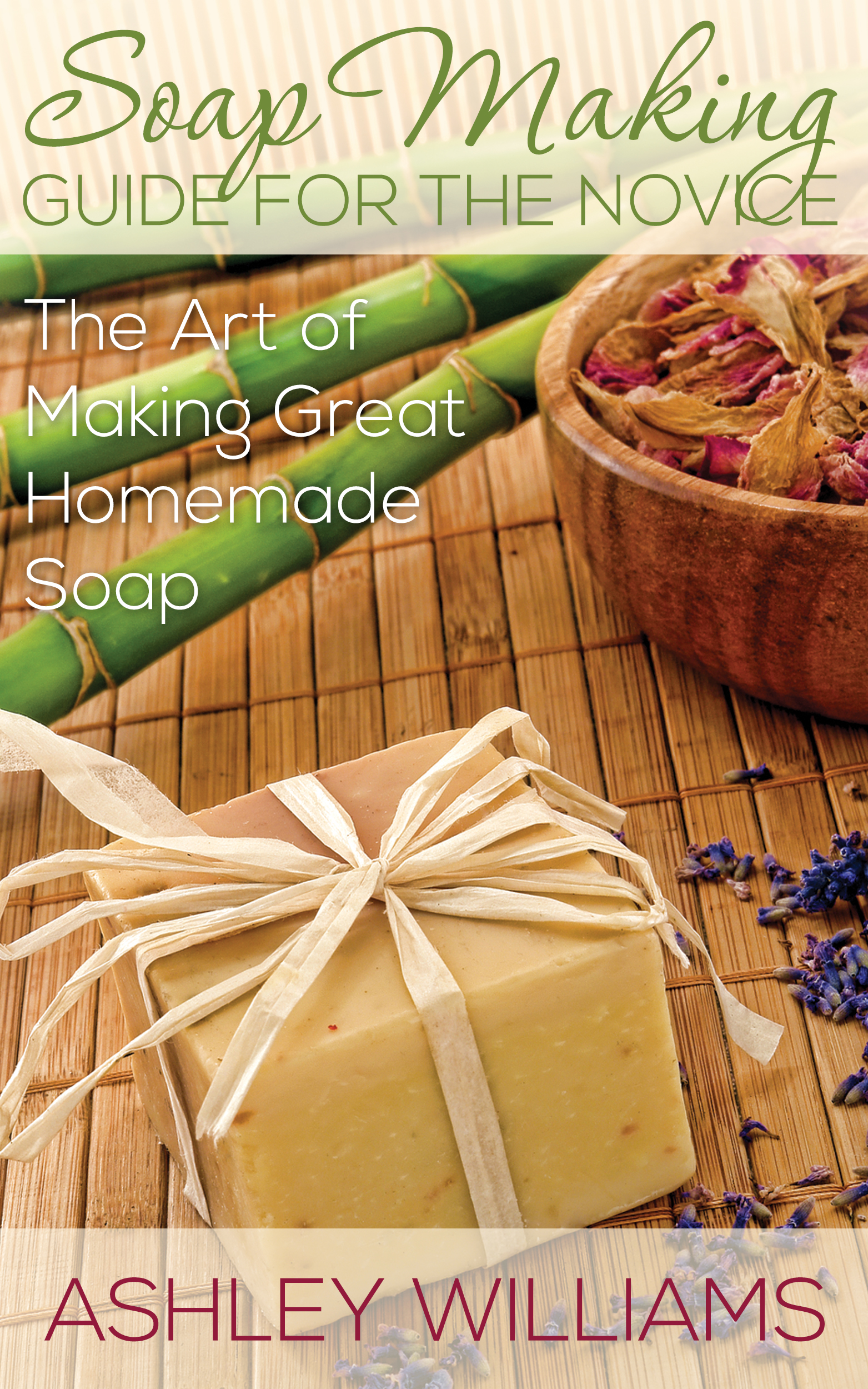Soap Making Guide for the Novice
The Art of Making Great Homemade Soap
By: Ashley Williams
TABLE OF CONTENTS
PUBLISHERS NOTES
Disclaimer
This publication is intended to provide helpful and informative material. It is not intended to diagnose, treat, cure, or prevent any health problem or condition, nor is intended to replace the advice of a physician. No action should be taken solely on the contents of this book. Always consult your physician or qualified health-care professional on any matters regarding your health and before adopting any suggestions in this book or drawing inferences from it.
The author and publisher specifically disclaim all responsibility for any liability, loss or risk, personal or otherwise, which is incurred as a consequence, directly or indirectly, from the use or application of any contents of this book.
Any and all product names referenced within this book are the trademarks of their respective owners. None of these owners have sponsored, authorized, endorsed, or approved this book.
Always read all information provided by the manufacturers product labels before using their products. The author and publisher are not responsible for claims made by manufacturers.
2014
Manufactured in the United States of America
DEDICATION
This book is dedicated to my grandma Betty. Her knowledge of making homemade soaps and doing canning and preserving are priceless.
CHAPTER 1- THE EVOLUTION OF SOAP- WHERE IT ORIGINATED AND HOW IT IS MADE?
Cleanliness is something that most people aspire to and to do so one must use a cleaning agent of some form. Generally, this is soap. It is quite interesting that a product which is so universally used has not been given more consideration. Yet, soap is a very interesting thing with a history which dates back almost as long as time itself.
The Beginnings
There is no definitive date established for when the first soap was produced. However, one can find that ancient manuscripts dating back to biblical times mentioning soap. It has been suggested that either the Egyptians or the Romans were the first culture to make bar soap. Prior to such times the use of an ash and oil mixture was used.
Cutting the Fat
The first bar soaps were made from the fat of animals. The fat is commonly referred to as tallow. Literally, the fat was cut away and then compressed into bar form. One can see this in the early Spanish and Italian practices. The most common animal fat used was that of goats and rams. When commercially made soaps emerged pig fat was introduced as a standard for making soap. However, one should note that the fat from many animals including cattle have been used to make soaps in the past.
They Made Lye
With any commercial endeavor, it was soon discovered that soap could be made more efficiently. By using hardwood ash and water, Lye, and a form of grease or fat bonding soap could be massed produced. The lye was the solution which emerged from running water through a barrel (which usually contained natural filters such as straw and gravel) containing the ashes of hardwood. The brownish mixture would then be tested for consistency. The fat or grease bonding was then added to the lye solution. To do this the fat was melted down with heat and added to the lye. Upon boiling, the soap was then added to a framing box (usually wooden) to cool. Once cooled the blocks were cut into bars and distributed.
It is attributed to the Spanish and Italians for introducing soap in the bar format that one knows today. It has been mentioned that the royalty of England first demanded fragrances in their soaps. Just like in today's society, what is popular for the elite quickly becomes the trend. Fragrances were soon added to the majority of soaps. Although the method is still used by several soap makers especially those that want to obtain a more natural and organic method, the progression of the world would require a way in which soap should be produced much more quickly and in larger quantities.
Synthetic Soap
Like many items that are used commercially today, the original design of soap as we know it was born from necessity. Because of the medical needs that were presented in World War 1 as well as the lack of animals that were available, a synthetic method of producing soap was needed. It was actually German scientists that invented the method which could produce mass quantities of soap in a weeks time. Yet, this soap was known for the irritations that it caused to the skin. Such can be contributed to the chemicals and quick method in which such soap was produced. Therefore the process needed refinement. The soap making process was successfully modified with Proctor and Gamble's continuous process.
Continuing On
The Continuous process of soap developed by Proctor and Gamble involved a method that separated the fats used in soap. The glycerin and fatty acids get separated using extremely hot water under high pressure. By separating the fats impurities can be removed from the fatty acids. The fat is then added to an alkali solution, cooled, and cut while the glycerin is considered waste.
Waste Not, Want Not
One would think that waste such as glycerin would be discarded after making soap. However, with the evolution of soap and how it is made the waste has come to serve a purpose in the beauty products world. Many lotions and such are developed using the waste from the continuous process. This means that a great deal of the liquid soaps, hand lotions, and creams contain large amounts of glycerin. This is something that should raise the attention of those concerned with keep him or herself naturally clean.
Extras
In today's society, soap is greatly influenced by the fragrance which it produces upon the skin. These additives are usually added during the cooling process or right before the soap is poured to be formed. In the creation of natural bar soap, these ingredients are added to the framing box when the compound is poured prior to cutting. One should be mindful that fragrances added could produce irritants. Also, one should also keep in mind the fermentation of any natural substances added to the soap; adding an ingredient that quickly ferments would not produce the fragrance desired.
Keep It Natural
If one looks at the evolution of soap and how it is made, he or she will note that the method has remained relatively the same. What has changed is the way in which the fat is processed and the bonding agent. Out of need and greed the additives have evolved into the state of our modern soap. One that is seeking to have a healthier and more natural way of cleanliness would be best to keep to the older method of producing soap using either Lye or pure fat.
CHAPTER 2- MAKING SOAP- THE NECESSARY EQUIPMENT
Why It Is Important To Be Able To Make Soap?
Whether you are a survivalist or just seeking to be prepared for any major natural event which would cut you off from normal access to goods and services; being able to make soap is essential. While having access to potable water is essential; soap is even more critical as it sanitizes and promotes healthy and sanitary clean living. It holds back the spread of germs and other unclean organisms which can cause the spread of major ailments and even pandemics.

